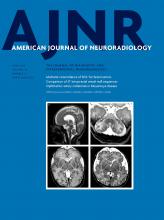Research ArticleAdult Brain
Blood Flow Mimicking Aneurysmal Wall Enhancement: A Diagnostic Pitfall of Vessel Wall MRI Using the Postcontrast 3D Turbo Spin-Echo MR Imaging Sequence
E. Kalsoum, A. Chabernaud Negrier, T. Tuilier, A. Benaïssa, R. Blanc, S. Gallas, J.-P. Lefaucheur, A. Gaston, R. Lopes, P. Brugières and J. Hodel
American Journal of Neuroradiology June 2018, 39 (6) 1065-1067; DOI: https://doi.org/10.3174/ajnr.A5616
E. Kalsoum
aFrom the Departments of Neuroradiology (E.K., A.C.N., T.T., A.B., S.G., A.G., P.B., J.H.)
A. Chabernaud Negrier
aFrom the Departments of Neuroradiology (E.K., A.C.N., T.T., A.B., S.G., A.G., P.B., J.H.)
T. Tuilier
aFrom the Departments of Neuroradiology (E.K., A.C.N., T.T., A.B., S.G., A.G., P.B., J.H.)
A. Benaïssa
aFrom the Departments of Neuroradiology (E.K., A.C.N., T.T., A.B., S.G., A.G., P.B., J.H.)
R. Blanc
cDepartment of Interventional Neuroradiology (R.B.), Rothschild Foundation Hospital, Paris, France
S. Gallas
aFrom the Departments of Neuroradiology (E.K., A.C.N., T.T., A.B., S.G., A.G., P.B., J.H.)
J.-P. Lefaucheur
bNeurophysiology (J.-P.L.), Centre Hospitalier Universitaire Henri Mondor, Créteil, France
A. Gaston
aFrom the Departments of Neuroradiology (E.K., A.C.N., T.T., A.B., S.G., A.G., P.B., J.H.)
R. Lopes
dNeuroradiology Department (R.L.), Univ. Lille, INSERM, CHU Lille, U1171 - Degenerative and Vascular Cognitive Disorders, Lille, France.
P. Brugières
aFrom the Departments of Neuroradiology (E.K., A.C.N., T.T., A.B., S.G., A.G., P.B., J.H.)
J. Hodel
aFrom the Departments of Neuroradiology (E.K., A.C.N., T.T., A.B., S.G., A.G., P.B., J.H.)

REFERENCES
- 1.↵
- Mandell DM,
- Mossa-Basha M,
- Qiao Y, et al
- 2.↵
- Edjlali M,
- Gentric JC,
- Régent-Rodriguez C, et al
- 3.↵
- 4.↵
- 5.↵
- 6.↵
- Nagahata S,
- Nagahata M,
- Obara M, et al
- 7.↵
- 8.↵
- Omodaka S,
- Endo H,
- Niizuma K, et al
- 9.↵
- 10.↵
- Wang J,
- Yarnykh VL,
- Hatsukami T, et al
- 11.↵
- 12.↵
- 13.↵
- 14.↵
- 15.↵
- Cebral J,
- Ollikainen E,
- Chung BJ, et al
In this issue
American Journal of Neuroradiology
Vol. 39, Issue 6
1 Jun 2018
Advertisement
E. Kalsoum, A. Chabernaud Negrier, T. Tuilier, A. Benaïssa, R. Blanc, S. Gallas, J.-P. Lefaucheur, A. Gaston, R. Lopes, P. Brugières, J. Hodel
Blood Flow Mimicking Aneurysmal Wall Enhancement: A Diagnostic Pitfall of Vessel Wall MRI Using the Postcontrast 3D Turbo Spin-Echo MR Imaging Sequence
American Journal of Neuroradiology Jun 2018, 39 (6) 1065-1067; DOI: 10.3174/ajnr.A5616
0 Responses
Blood Flow Mimicking Aneurysmal Wall Enhancement: A Diagnostic Pitfall of Vessel Wall MRI Using the Postcontrast 3D Turbo Spin-Echo MR Imaging Sequence
E. Kalsoum, A. Chabernaud Negrier, T. Tuilier, A. Benaïssa, R. Blanc, S. Gallas, J.-P. Lefaucheur, A. Gaston, R. Lopes, P. Brugières, J. Hodel
American Journal of Neuroradiology Jun 2018, 39 (6) 1065-1067; DOI: 10.3174/ajnr.A5616
Jump to section
Related Articles
- No related articles found.
Cited By...
- A Review of Intracranial Aneurysm Imaging Modalities, from CT to State-of-the-Art MR
- DANTE-CAIPI Accelerated Contrast-Enhanced 3D T1: Deep Learning-Based Image Quality Improvement for Vessel Wall MRI
- Improved Blood Suppression of Motion-Sensitized Driven Equilibrium in High-Resolution Whole-Brain Vessel Wall Imaging: Comparison of Contrast-Enhanced 3D T1-Weighted FSE with Motion-Sensitized Driven Equilibrium and Delay Alternating with Nutation for Tailored Excitation
- Quantitative analysis of unruptured intracranial aneurysm wall thickness and enhancement using 7T high resolution, black blood magnetic resonance imaging
- Image-Quality Assessment of 3D Intracranial Vessel Wall MRI Using DANTE or DANTE-CAIPI for Blood Suppression and Imaging Acceleration
- Vessel wall imaging in intracranial aneurysms
- Reply:
- Comment on "Blood Flow Mimicking Aneurysmal Wall Enhancement: A Diagnostic Pitfall of Vessel Wall MRI Using the Postcontrast 3D Turbo Spin-Echo MR Imaging Sequence"
This article has not yet been cited by articles in journals that are participating in Crossref Cited-by Linking.
More in this TOC Section
Similar Articles
Advertisement











